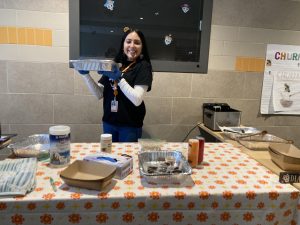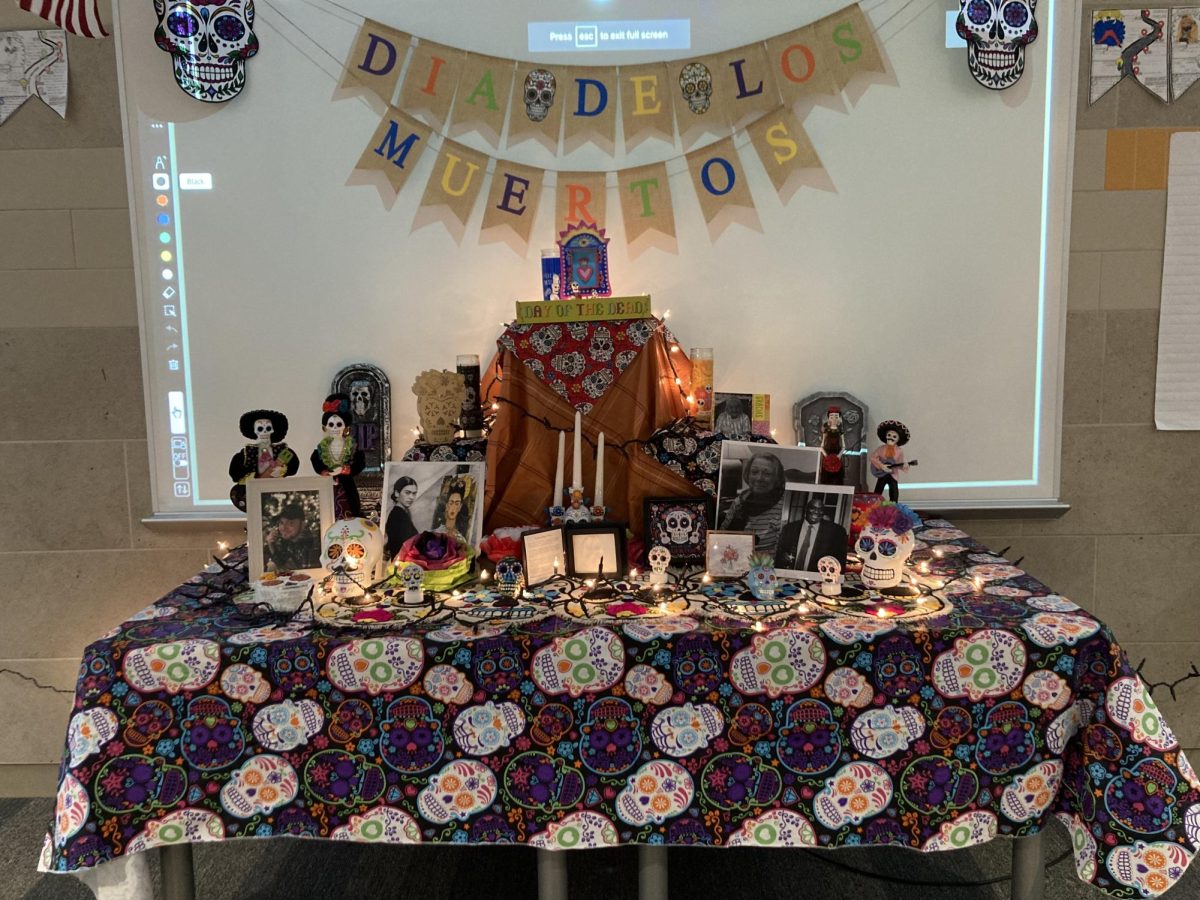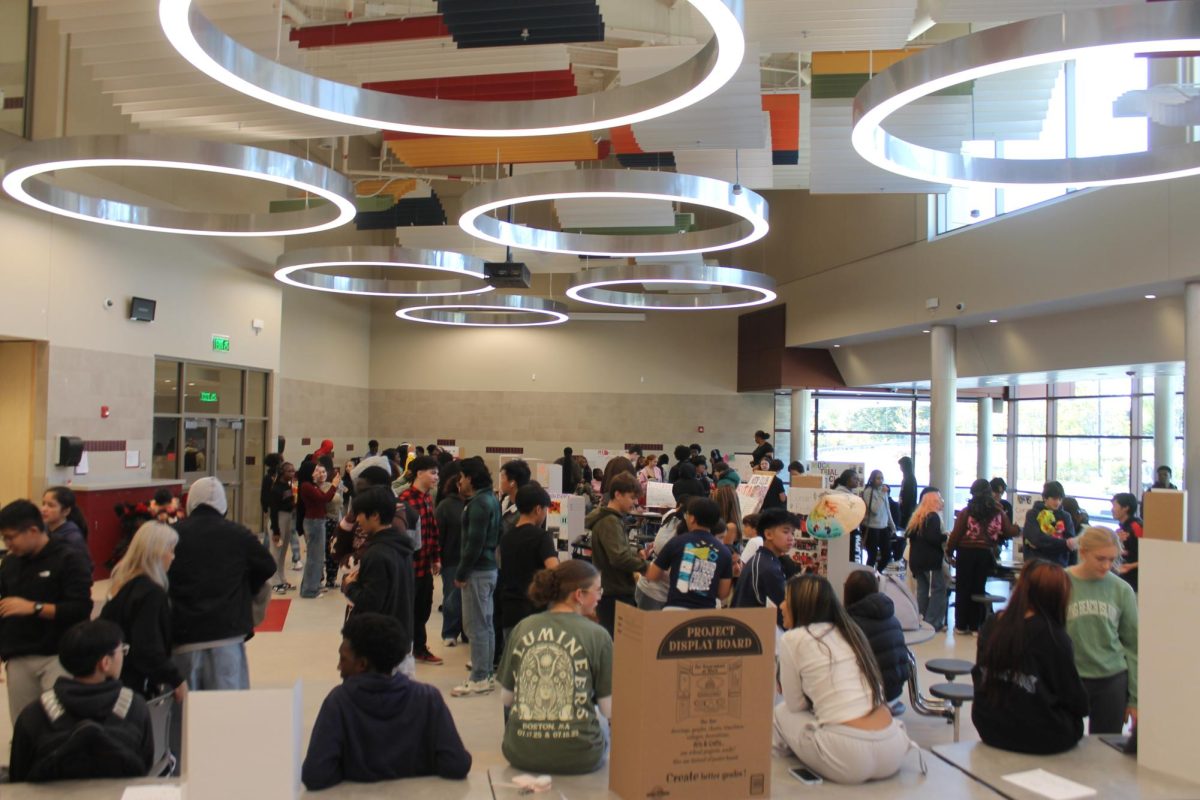From Wednesday, November 1st through Friday, November 3rd, the Spanish hallway on the third floor was filled with the thick smell of frying oil. Mariachi music played on a computer hooked up to the speakers in the common area, as foreign language students lined up in the hallway and moved from station to station, picking up the empanadas and churros they had ordered weeks ago. Against the white board in the common area, the Spanish teachers had constructed an ofrenda, an altar, covered in candles, sugar skulls, and pictures of loved ones. Strung across the white board were the words “Día de los Muertos.”
As part of the Spanish curriculum, particularly in Spanish I, students at South learn about Hispanic holidays and traditions, including Día de los Muertos (the Day of the Dead), which honors deceased ancestors.
According to the Spanish and Foreign Language department head Mr. Leon, making and selling traditional foods like empanadas and churros helps students to engage with the concepts they learn about in class. Additionally, for students and faculty who value Día de los Muertos, like Mr. Leon, it is meaningful to represent the holiday during school.
The Spanish department sold empanadas and churros last year, as well, but Mr. Leon said that this year went “much smoother.” For example, last year it was difficult to keep track of which students had ordered food—this year, students ordered through their foreign language teacher, who put their order in a spreadsheet, for better organization.
Furthermore, last year, “it got a little chaotic,” Mr. Leon said, because the department sold both chicken and beef empanadas, but once they were assembled, “you can’t tell which one is which.” To minimize confusion, they only sold beef empanadas this year.
Despite the lessons that Mr. Leon and his colleagues learned from last year, an enormous effort still went into selling the empanadas and churros. “It’s a lot of work, a lot of behind the scenes,” he explained.
Over the weekend, Ms. Happy cooked an estimated 50 pounds of ground beef, he said. Then, on Saturday, Monday, Tuesday, and even Wednesday, students and teachers, including Ms. DiOrio, Ms. Vargas, and Ms. Roy, assembled the empanadas. Some students received extra credit for helping.
“Once you make the meat, you have to get the [pre-made dough] disks and let them thaw,” Mr. Leon said. Then, “you have to fill them and press them,” and this must all be done within a certain amount of time, before the dough dries out. After that, the empanadas are frozen. Then, on the days they are sold, they are fried and given to students. The Spanish department brought fryolators to fry both the empanadas and churros. Each empanada or churro was $2, and the funds paid for the department to buy ingredients and assemble the food; there was no profit made. Mr. Leon estimated that combined, the department had prepared 1,400 empanadas and churros.
The churros were purchased pre-made online, ready to be fried and distributed with cinnamon sugar, chocolate, or caramel. Ms. DiOrio was running the churro station on Thursday, November 2. By Thursday afternoon, she estimated she had sold more than 450 churros.

“It’s stressful,” she said, but this was her second year doing it, so she had experience. Additionally, students helped her to prepare the toppings for the churros, and the culinary department provided the Spanish teachers with gloves, as well as tray boats for the churros.
Despite how hectic it can be at times, Ms. DiOrio thought it was “really worth it in the end.” She said, “It’s nice to hear [the students] say ‘caramelo’ or ‘chocolate,’” if they know the Spanish words. Beyond that, she valued the help that students gave her.
Rosi Magaña, ‘24, had many different roles in the process, including making the empanadas after school, from 2-4pm on Tuesday and Wednesday. “My hand is killing me, but it’s okay,” she joked.
Magaña was also helping to distribute the empanadas. She volunteered all day on Wednesday and from third period onward on Thursday. She helped out partly because Ms. DiOrio was an important teacher for her during freshman year, but also because she valued Día de los Muertos. “We celebrate our [passed loved ones],” she said, so they can “pass the border and come see us.”
The Spanish teachers even created an ofrenda, or an altar, in the common area. Not only does this help students understand the concept of an ofrenda, Mr. Leon said, but it commemorates and honors the lives of people important to the Spanish teachers.
Pictures of “my grandmother, my mother-in-law, and one of my former teachers [who was] my daughter’s god-father,” are all on the ofrenda, said Mr. Leon. So were Ms. Happy’s son and her dog.
Having an ofrenda and making food like empanadas and churros was meaningful, and “you’re bringing your culture to the students, and they see it first-hand,” explained Mr. Leon.
Additionally, “you get to see the kids in a different way,” said Mr. Leon. “They enjoy it, and I think they remember those things.”
For Magaña, the best part of volunteering was spending time with teachers outside the classroom. “[We] have fun,” she said. “When it’s quiet. . . they’re fun, they laugh.” Though she is graduating this year, Magaña hoped that more students would help out next year. “It’s [better] to have teachers and students working together.”
“It takes an army,” Ms. DiOrio said, “but really, it’s a good way to bring our classes together.”
The Spanish department is hoping to sell food again later in the year, around the International Show, Mr. Leon explained. They are also hoping to incorporate more Hispanic traditions. “We don’t know if it’s going to happen yet, but [it would be] la parranda—it’s equivalent to traditional caroling” during the holiday season, he explained. It would begin with only a few students going from classroom to classroom singing, and then would gain more and more as it went.
Regardless of the form it took, Mr. Leon thought it was important to bring real life traditions into the classroom: “Instead of reading about it or watching a movie, they actually see it, which is good.”
“They’re excited about it,” he said. “They all get excited about it.”








